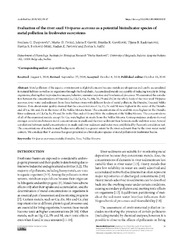Приказ основних података о документу
Evaluation of the river snail Viviparus acerosus as a potential bioindicator species of metal pollution in freshwater ecosystems
| dc.creator | Despotović, Svetlana | |
| dc.creator | Prokić, Marko | |
| dc.creator | Gavrić, Jelena | |
| dc.creator | Gavrilović, Branka | |
| dc.creator | Radovanović, Tijana | |
| dc.creator | Borković Mitić, Slavica | |
| dc.creator | Pavlović, Slađan | |
| dc.creator | Saičić, Zorica | |
| dc.date.accessioned | 2019-05-30T10:42:28Z | |
| dc.date.available | 2019-05-30T10:42:28Z | |
| dc.date.issued | 2019 | |
| dc.identifier.uri | http://www.doiserbia.nb.rs/Article.aspx?ID=0354-46641800045D | |
| dc.identifier.uri | http://www.serbiosoc.org.rs/arch/index.php/abs/article/view/3270 | |
| dc.identifier.uri | https://radar.ibiss.bg.ac.rs/handle/123456789/3355 | |
| dc.description.abstract | Metal pollution of the aquatic environment is of global concern because metals are ubiquitous and can be accumulated in natural habitats as well as in organisms through the food chain. Accumulated metals are capable of inducing toxicity in living organisms, altering their reproductive success, behavior, immune response and biochemical processes. We examined the correlation between the concentrations of 9 metals (As, Cd, Cr, Cu, Fe, Mn, Ni, Pb and Zn) in the whole body of the river snail Viviparus acerosus, river water and sediment from three Serbian rivers with different levels of metal pollution, the Danube, Tisa and Velika Morava. Data about water quality showed that the concentrations of As, Cr, Fe and Ni were highest in the water of the Danube and of Cu, Mn and Zn in the water of the Velika Morava River. The concentrations of As and Mn were highest in the Danube River sediment, of Cd, Cu, Fe, Pb and Zn in the Tisa and of Cr and Ni in the sediment of the Velika Morava. The concentrations of all of the examined metals, except for Cu, were highest in snails from the Velika Morava. Correspondence analysis showed stronger correlations between metal concentrations in snails and the river sediment than between snails and river water. Several correlations between metal concentrations in snails and river sediment and water were established by Pearson’s correlation test. The concentrations of metals in snail bodies were affected to a greater extent by the river sediment than by the river-water metal content. We conclude that V. acerosus has great potential as a bioindicator species of metal pollution in freshwater basins. | en |
| dc.relation | info:eu-repo/grantAgreement/MESTD/Basic Research (BR or ON)/173041/RS// | |
| dc.rights | openAccess | |
| dc.rights.uri | https://creativecommons.org/licenses/by-nc-nd/4.0/ | |
| dc.source | Archives of Biological Sciences | |
| dc.subject | Danube | |
| dc.subject | Tisa | |
| dc.subject | Velika Morava | |
| dc.subject | Viviparus acerosus | |
| dc.subject | Metals | |
| dc.title | Evaluation of the river snail Viviparus acerosus as a potential bioindicator species of metal pollution in freshwater ecosystems | en |
| dc.type | article | en |
| dc.rights.license | BY-NC-ND | |
| dcterms.abstract | Гаврић, Јелена; Деспотовић, Светлана; Гавриловић, Бранка; Радовановић, Тијана; Борковић-Митић, Славица; Павловић, Слађан; Саичић, Зорица; Прокић, Марко; | |
| dc.rights.holder | © 2019 by the Serbian Biological Society | |
| dc.citation.issue | 1 | |
| dc.citation.volume | 71 | |
| dc.identifier.doi | 10.2298/ABS180801045D | |
| dc.identifier.scopus | 2-s2.0-85065481794 | |
| dc.identifier.wos | 000463592100005 | |
| dc.citation.apa | Despotović, S., Prokić, M., Gavrić, J., Gavrilović, B., Radovanović, T., Borković-Mitić, S., et al. (2019). Evaluation of the river snail Viviparus acerosus as a potential bioindicator species of metal pollution in freshwater ecosystems. Archives of Biological Sciences, 71(1), 39–47. | |
| dc.citation.vancouver | Despotović S, Prokić M, Gavrić J, Gavrilović B, Radovanović T, Borković-Mitić S, Pavlović S, Saičić Z. Evaluation of the river snail Viviparus acerosus as a potential bioindicator species of metal pollution in freshwater ecosystems. Arch Biol Sci. 2019;71(1):39–47. | |
| dc.citation.spage | 39 | |
| dc.citation.epage | 47 | |
| dc.type.version | publishedVersion | en |
| dc.identifier.fulltext | https://radar.ibiss.bg.ac.rs//bitstream/id/5033/ABS-71-1-039-047.pdf | |
| dc.citation.rank | M23 |

